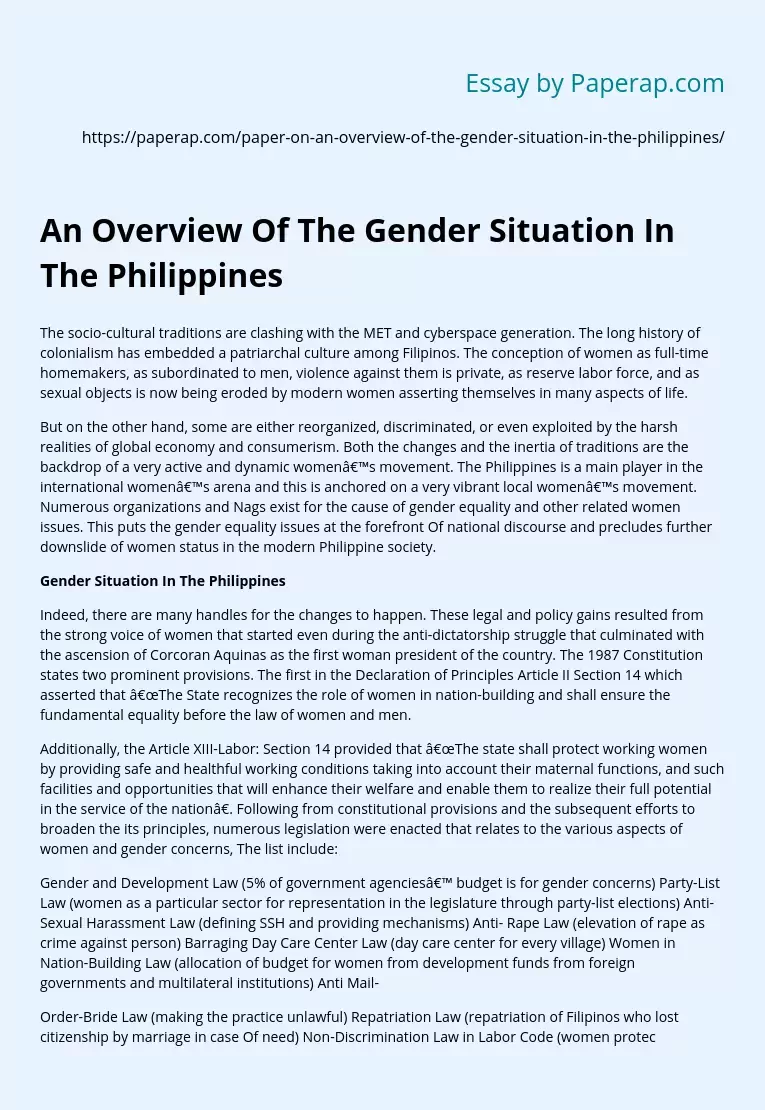The socio-cultural traditions are clashing with the MET and cyberspace generation. The long history of colonialism has embedded a patriarchal culture among Filipinos. The conception of women as full-time homemakers, as subordinated to men, violence against them is private, as reserve labor force, and as sexual objects is now being eroded by modern women asserting themselves in many aspects of life.
But on the other hand, some are either reorganized, discriminated, or even exploited by the harsh realities of global economy and consumerism.
Both the changes and the inertia of traditions are the backdrop of a very active and dynamic women’s movement. The Philippines is a main player in the international women’s arena and this is anchored on a very vibrant local women’s movement. Numerous organizations and Nags exist for the cause of gender equality and other related women issues. This puts the gender equality issues at the forefront Of national discourse and precludes further downslide of women status in the modern Philippine society.
Gender Situation In The Philippines
Indeed, there are many handles for the changes to happen. These legal and policy gains resulted from the strong voice of women that started even during the anti-dictatorship struggle that culminated with the ascension of Corcoran Aquinas as the first woman president of the country. The 1987 Constitution states two prominent provisions. The first in the Declaration of Principles Article II Section 14 which asserted that “The State recognizes the role of women in nation-building and shall ensure the fundamental equality before the law of women and men.
Additionally, the Article XIII-Labor: Section 14 provided that “The state shall protect working women by providing safe and healthful working conditions taking into account their maternal functions, and such facilities and opportunities that will enhance their welfare and enable them to realize their full potential in the service of the nation”. Following from constitutional provisions and the subsequent efforts to broaden the its principles, numerous legislation were enacted that relates to the various aspects of women and gender concerns, The list include:
Gender and Development Law (5% of government agencies’ budget is for gender concerns) Party-List Law (women as a particular sector for representation in the legislature through party-list elections) Anti-Sexual Harassment Law (defining SSH and providing mechanisms) Anti- Rape Law (elevation of rape as crime against person) Barraging Day Care Center Law (day care center for every village) Women in Nation-Building Law (allocation of budget for women from development funds from foreign governments and multilateral institutions) Anti Mail-
Order-Bride Law (making the practice unlawful) Repatriation Law (repatriation of Filipinos who lost citizenship by marriage in case Of need) Non-Discrimination Law in Labor Code (women protection in hiring and pay) Comprehensive Agrarian Reform Law (equal rights for women to be recipients of land) Military Training equality (women can enter the military and police schools and providing facilities for them) While the legal framework is there, the actual situation mirrors the deep gender divide. In the aspect of women in politics, the notable success of overall women is overshadowed by the actual ground level statistics.
The lady Vice-President is up to now a shoo-in in the next presidential elections in 2004. But the big picture shows that of all the elective positions occupied through the 1998 elections, only 15% are women. In the two-chamber Congress, the Senate (Upper House) has 17. 4% women membership (4 out of 23 seats) which the House of Representatives (Lower House) has 12. 4% (27 out of 217 seats). The first party-list elections in 1998– wherein sector’s groups like women competed to get a maximum of 3 seats ere party in the House of Representatives–resulted in the winning of one (1) seat for a single women’s party.
Five (5) Other women’s party did not make the minimum votes required. At the local government level, women Provincial Governors constitute 17% while Vicegerents are at 1 1. 5% level. Among the City and Town Mayors, 14. 5% of them are women while the ranks of the Vice- Mayors are at low of 10. 8%. The labor force statistics show also a mixed picture. Since there was a notable finalization of the workforce in the past years, July 2000 figures showed that there are 1. 42 million unemployed women while there are 2. 31 million unemployed men. However, more women are taken in for labor flexibility arrangements especially in the big services sector like in retail trade. This leaves them exposed to employment insecurity and unfair compensation schemes. Women still accounts for 53% of the unpaid family workers while they constitute only 37. 7% of the wage and salary earners. Though this shows that the regular income possibilities for women are still limited, the average household annual income of female-headed families is higher.
The situation also pushes them to seek employment overseas. Increasing numbers of domestic helpers and entertainers are also being deployed both legally and illegally. Within organizations, the gender balance is under overhaul. Trade union leadership is still male-dominated but women committees and affirmative actions have changed the complexion of decision-making.
An Overview Of The Gender Situation In The Philippines. (2019, Dec 05). Retrieved from https://paperap.com/paper-on-an-overview-of-the-gender-situation-in-the-philippines/

